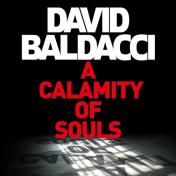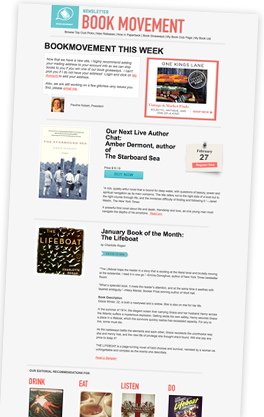BKMT READING GUIDES
A Calamity of Souls
by David Baldacci
Paperback : 512 pages
12 clubs reading this now
1 member has read this book
Introduction
Set in the tumultuous year of 1968 in southern Virginia, a racially charged murder case sets a duo of white and Black lawyers against a deeply unfair system as they work to defend their wrongfully accused Black defendants in this courtroom drama from #1 New York Times bestselling author David Baldacci.
Jack Lee is a white lawyer from Freeman County, Virginia, who has never done anything to push back against racism—until he decides to represent Jerome Washington, a Black man charged with brutally killing an elderly wealthy white couple. Doubting his decision, Lee fears that his legal skills may not be enough to prevail in a case where the odds are already stacked against both him and his client. He quickly finds himself out of his depth when he realizes that what's at stake is far greater than the outcome of a murder trial.
Desiree DuBose is a Black lawyer from Chicago who has devoted her life to furthering the causes of justice and equality for all. She enters a fractious and unwieldy partnership with Lee in a legal battle against the best prosecutor in the Commonwealth. Yet DuBose is also aware that powerful outside forces are at work to blunt the victories achieved by the Civil Rights era.
Lee and DuBose could not be more dissimilar. On their own, neither one can stop the prosecution’s deliberate march towards a guilty verdict and the electric chair. But together, the pair fight for what once seemed impossible: a chance for a fair trial and true justice.
Over a decade in the making, A Calamity of Souls breathes richly imagined and detailed life into a bygone era, taking the reader through a world that will seem both foreign and familiar.
Editorial Review
No Editorial Review Currently AvailableExcerpt
In the cell there was one barred window, a rickety wooden chair, a short, narrow bunk, a stained commode, a cracked porcelain sink. And him.“What happened to you?” asked Jack as the door clanged shut behind him.
Jerome Washington was sitting on the bunk, staring at the wall. The fact that his head was wrapped in a blood-soaked bandage and his face was bruised had prompted Jack’s question. Instead of a jail-issued garment, he apparently had on the same clothes he’d been arrested in. Denim, sweat-stained long-sleeved work shirt, worn dungarees, and old boots with the edges curled, like the man was melting from the bottom up. He was large and robustly built, and in his midtwenties. He was several inches taller than Jack and carried eighty more pounds. His hair was short, and a trim beard covered his jutting jaw and curved over his top lip. ...
Discussion Questions
From the publisher-- added by Pauline:1) What was your reaction to the opening chapter, in which Jerome is being arrested? How did the scene set your expectations for the rest of the novel?
2) By the end of the novel, the key takeaway is that Jack and Desiree each needed the other in order to get a not-guilty verdict for their clients. What qualities/traits in each of them were critical to the success of their partnership?
3) After agreeing to represent Jerome, Jack immediately doubts whether he should have done so and if he has the skill to make a sound case for his client. What factors created this uncertainty in Jack and how do you think he overcomes them?
4) How do you think the case would have played out had Jack stepped down and allowed Desiree to take over completely? Additionally, how do you think it would have turned out had Desiree never come to town to offer her expertise?
5) In Freeman County, many of the citizens are resistant to change and the Black-white divide is staunchly held, even to the point of framing a Black couple for murder. While this is a fictional county, how did this story teach you about that time period in American history? Did you learn something new? If yes, what was it?
6) While Jack and Desiree aren’t on trial for committing any crimes, they are still villainized by some for defending their Black clients and furthering the causes of social justice. And their work then puts their lives, and the lives of their loved ones, at risk. What would you have done if you found yourself in that position? Why?
7) Hilda Lee is a complex character with a past she wants to keep hidden and an outward appearance she wants to keep up. How do you think this affected the way she raised her children? What cues did Jack pick up on that shaped his view of the world, even if he didn’t realize it?
8) At the end of the book, while justice is achieved, the ending is not completely happy. How did you expect the story to end and why did you come to that conclusion? And how did the actual ending make you rethink the ways in which people hold on to hate, even when there’s evidence of innocence and inequality within the system?
Weblinks
| » |
Publisher's book info
|
| » |
David Baldacci's official website
|
| » |
Read an excerpt
|
| » |
Download the book club kit
|
Notes From the Author to the Bookclub
Author's Note, written by David Baldacci: I started writing this novel well over a decade ago, by hand, in a journal like the one my mother gave me as a child to jot down my stories. Then I set the manuscript aside to work on other projects, but something kept pulling me back to the story, and it has to do with my past. I grew up in the sixties and seventies in Richmond, Virginia, the old capital of the Confederacy, home to all those statues of rebel elites on Monument Avenue. I was not born into economic privilege, and I grew up with an ethnic surname in a world steeped in the history of the Old South, where the names Lee, Jackson, Stuart, and Davis were revered by many. Thinking back, I believe I would not have become a writer had I not been born in that place and at that time. I was observant and curious, and I remember much from my youth. Where I grew up, the Black-white divide was so ingrained that despite the efforts of the Civil Rights movement and the Warren Court, life was not so very different from many decades before. The old ways were intractable, and accepted to such an extent that most people never even thought about it, at least people who looked like me. And while I was the observer of racial bigotry and hatred, I was never the target. To borrow a line from Mark Twain, that is truly the difference between the lightning bug and the lightning. There are many autobiographical elements in this story, from how Jack Lee grew up—although decades earlier than I did—to the thoughts, questions, and misgivings he had about the world in which he lived, how books played an important role in forming his outlook on life, the sometimes confusing and conflicting relationships with family and friends, and the uneasy coexistence of Black and white worlds, for they were distinct, separate entities. Like Jack, I delivered the morning paper, and I grew up to be a trial lawyer. My mechanic father fixed up an old Fiat that I drove for a period of time. And there is a Tuxedo Boulevard in Richmond, and, yes, to the best of my recollection, the county dump was at the end of the all-Black neighborhood. My sixth-grade class was one of the first in Virginia to be bused to a Black school, finally realizing Brown v. Board’s ruling, albeit nearly twenty years late. It was an emotionally and mentally bewildering time for all the students, which I looked back on for quite a while as traumatizing. However, as I grew older, I came to understand that it had been necessary to allow children from different walks of life to finally be together after having been separated for centuries for purely toxic reasons. When writing a novel dealing with race in America, the subject of the N-word usually comes up. I cannot think of another term that even approaches the heinous connotations of hatred and evil that stand next to it. However, to create a story set in 1968 that takes on issues of race and fails to use it in some form would be criticized, and justly so, as inauthentic at best, cowardly at worst. Thus, I have deployed it sparingly and in a hybrid form that may not satisfy some, but was the one I chose after much deliberation. Though distinct elements of self-governance date back as far as ancient Greece if not further, democracies were a thoroughly unproven and unpopular form of governance when America came into being. At that time, the most powerful nations were organized under autocratic systems, usually monarchies, and “individual freedom” was an oxymoron. Although there are other legitimate claimants to the title, the United States of America is arguably the world’s oldest nation with a continuously surviving democratic government; it is certainly the best-known example. However, having only been around for less than 250 years, we are an infant in the annals of history, and our existence has been, at times, uncomfortably turbulent. There were multiple instances in our past when we were at each other’s throats, and where a decisive breakup seemed imminent. We ultimately fought a costly civil war to end slavery and keep the union intact. Clearly, enough people believed the American experiment of freedom and self-governance was worth the bloodshed on all those battlefields. However, none of us should ever take that sentiment for granted, lest our system of elected representation disappears from under our distracted gaze, taking our hard-won rights along with it. Finally, I wanted to make this a story of two people from divergent life experiences who come together to tackle a problem as difficult as any America has ever confronted. I wanted it to be an unwieldy, fractious partnership, like the one experienced by those sixth graders decades ago. I wanted each to learn from the other, and for them to eventually find mutual respect and empathy for one another. In the end, what can we strive for that is more vital, for all of us?Book Club Recommendations
Recommended to book clubs by 1 of 1 members.
Book Club HQ to over 90,000+ book clubs and ready to welcome yours.
Get free weekly updates on top club picks, book giveaways, author events and more








